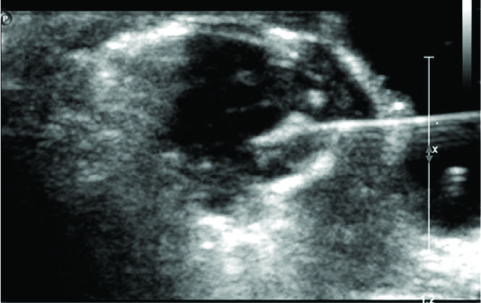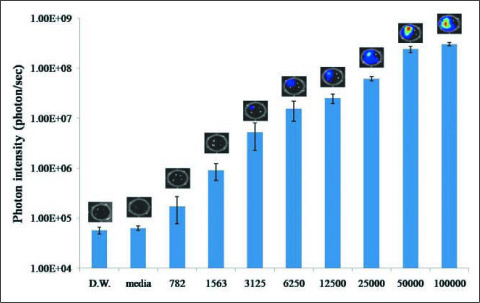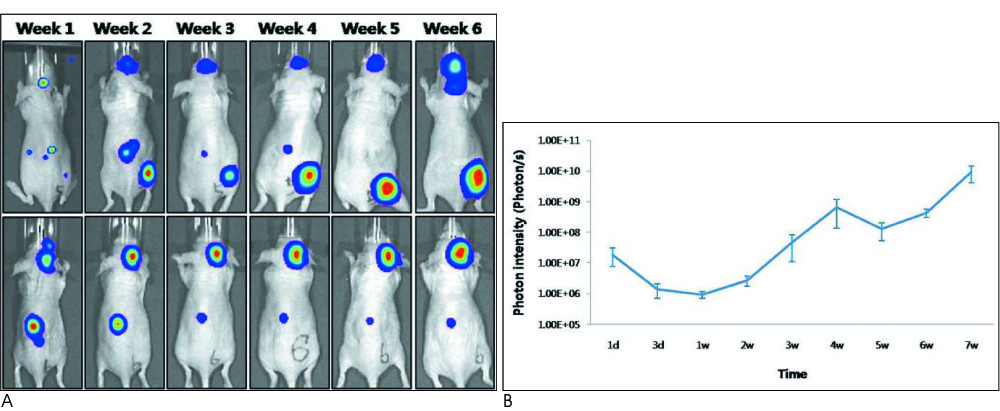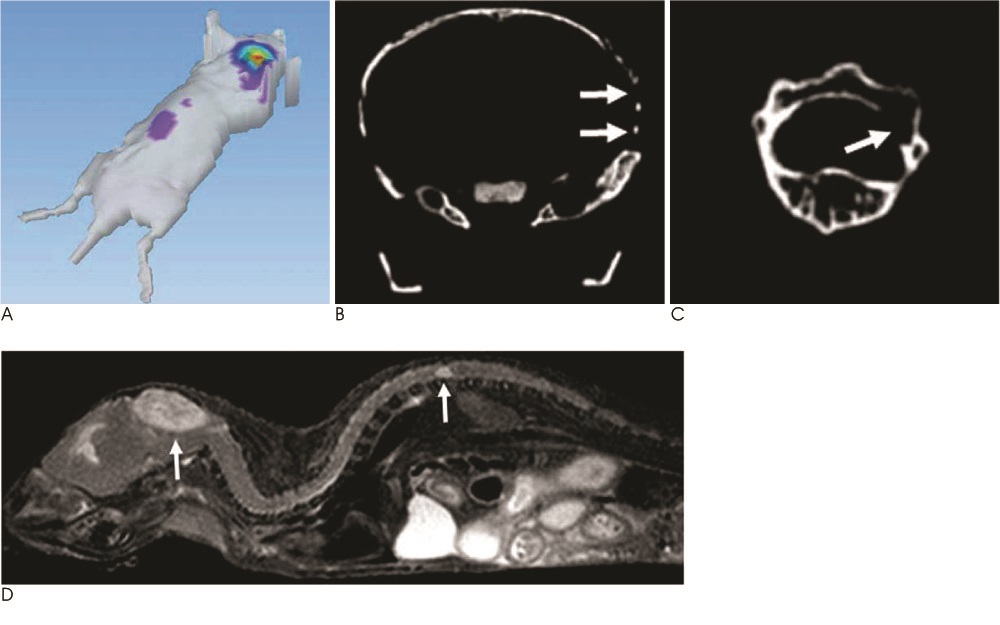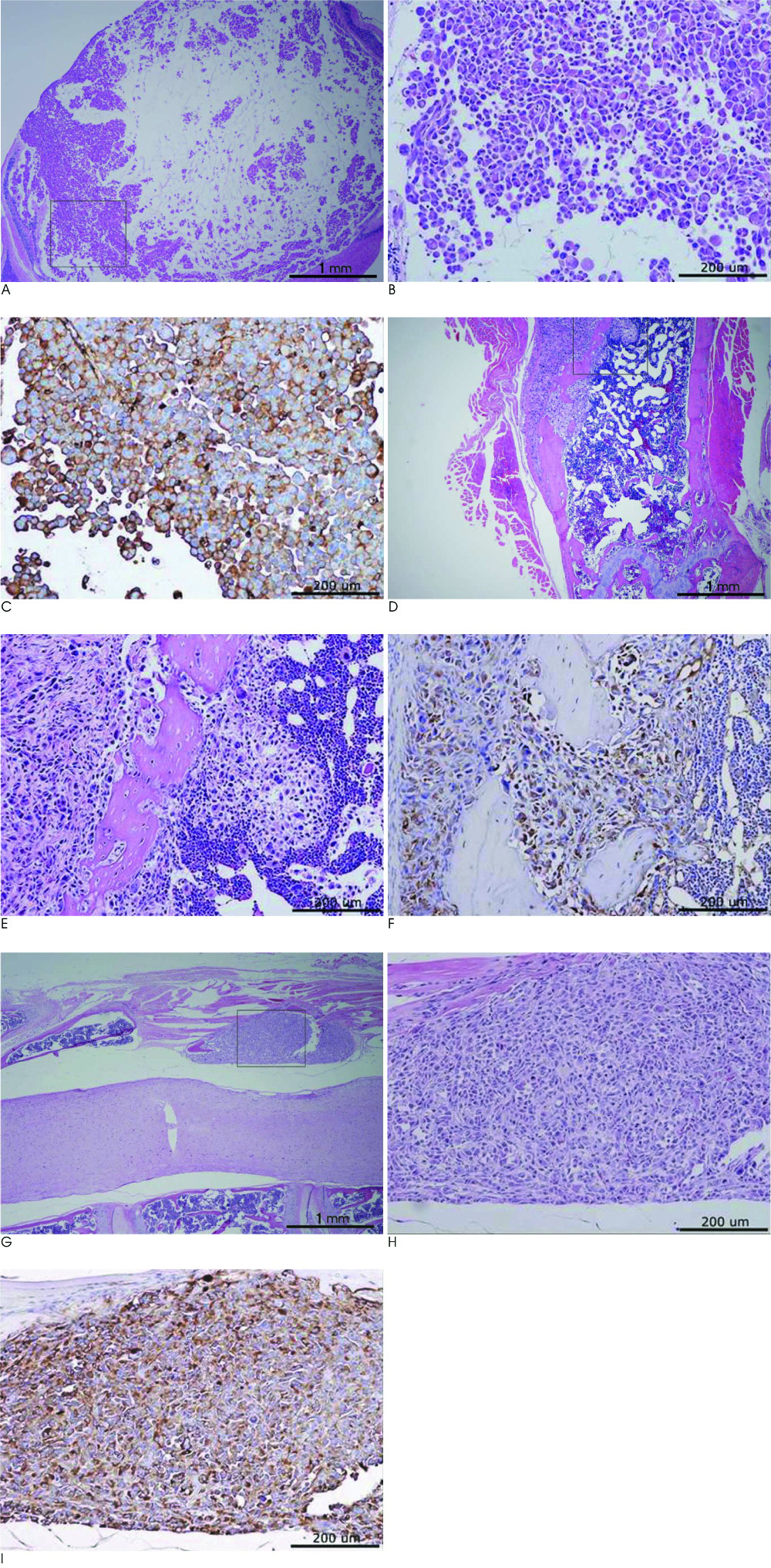J Korean Soc Radiol.
2011 Jan;64(1):57-65. 10.3348/jksr.2011.64.1.57.
A Bone Metastasis Nude Mouse Model Created by Ultrasound Guided Intracardiac Injection of Breast Cancer Cells: the Micro-CT, MRI and Bioluminescence Imaging Analysis
- Affiliations
-
- 1Department of Radiology, Research Institute of Radiological Science, College of Medicine, Yonsei University, Korea. hotsong@yuhs.ac
- 2National Core Research Center, Yonsei University, Korea.
- 3BK21 Project, College of Medicine, Yonsei University, Korea.
- 4Korean Minjok Leadership Academy, Korea.
- KMID: 1443583
- DOI: http://doi.org/10.3348/jksr.2011.64.1.57
Abstract
- PURPOSE
The purpose of this study was to develop a nude mouse model of bone metastasis by performing intracardiac injection of breast cancer cells under ultrasonography guidance and we wanted to evaluate the development and the distribution of metastasis in vivo using micro-CT, MRI and bioluminescence imaging.
MATERIALS AND METHODS
Animal experiments were performed in 6-week-old female nude mice. The animals underwent left ventricular injection of 2x105 MDA-MB-231Bo-Luc cells. After injection of the tumor cells, serial bioluminescence imaging was performed for 7 weeks. The findings of micro-CT, MRI and the histology were correlated with the 'hot' lesions seen on the bioluminescence imaging.
RESULTS
Metastasis was found in 62.3% of the animals. Two weeks after intracardiac injection, metastasis to the brain, spine and femur was detected with bioluminescence imaging with an increasing intensity by week 7. Micro-CT scan confirmed multiple osteolytic lesions at the femur, spine and skull. MRI and the histology were able to show metastasis in the brain and extraskeletal metastasis around the femur.
CONCLUSION
The intracardiac injection of cancer cells under ultrasonography guidance is a safe and highly reproducible method to produce bone metastasis in nude mice. This bone metastasis nude mouse model will be useful to study the mechanism of bone metastasis and to validate new therapeutics.
MeSH Terms
Figure
Reference
-
1. Yoneda T. Arterial microvascularization and breast cancer colonization in bone. Histol Histopathol. 1997; 12:1145–1149.2. Yoneda T, Sasaki A, Mundy GR. Osteolytic bone metastasis in breast cancer. Breast Cancer Res Treat. 1994; 32:73–84.3. Arguello F, Baggs RB, Frantz CN. A murine model of experimental metastasis to bone and bone marrow. Cancer Res. 1988; 48:6876–6881.4. Guise TA, Yin JJ, Taylor SD, Kumagai Y, Dallas M, Boyce BF, et al. Evidence for a causal role of parathyroid hormone-related protein in the pathogenesis of human breast cancer-mediated osteolysis. J Clin Invest. 1996; 98:1544–1549.5. Corey E, Quinn JE, Bladou F, Brown LG, Roudier MP, Brown JM, et al. Establishment and characterization of osseous prostate cancer models: intra-tibial injection of human prostate cancer cells. Prostate. 2002; 52:20–33.6. Wang CY, Chang YW. A model for osseous metastasis of human breast cancer established by intrafemur injection of the mda-mb-435 cells in nude mice. Anticancer Res. 1997; 17:2471–2474.7. Kjonniksen I, Winderen M, Bruland O, Fodstad O. Validity and usefulness of human tumor models established by intratibial cell inoculation in nude rats. Cancer Res. 1994; 54:1715–1719.8. Peterschmitt J, Bauerle T, Berger MR. Effect of zoledronic acid and an antibody against bone sialoprotein II on MDA-MB-231(GFP) breast cancer cells in vitro and on osteolytic lesions induced in vivo by this cell line in nude rats. Clin Exp Metastasis. 2007; 24:449–459.9. Bauerle T, Adwan H, Kiessling F, Hilbig H, Armbruster FP, Berger MR. Characterization of a rat model with site-specific bone metastasis induced by MDA-MB-231 breast cancer cells and its application to the effects of an antibody against bone sialoprotein. Int J Cancer. 2005; 115:177–186.10. Hsu WK, Virk MS, Feeley BT, Stout DB, Chatziioannou AF, Lieberman JR. Characterization of osteolytic, osteoblastic, and mixed lesions in a prostate cancer mouse model using 18F-FDG and 18F-Fluoride PET/CT. J Nucl Med. 2008; 49:414–421.11. Jenkins DE, Hornig YS, Oei Y, Dusich J, Purchio T. Bioluminescent human breast cancer cell lines that permit rapid and sensitive in vivo detection of mammary tumors and multiple metastases in immune deficient mice. Breast Cancer Res. 2005; 7:R444–R454.12. Minn AJ, Kang Y, Serganova I, Gupta GP, Giri DD, Doubrovin M, et al. Distinct organ-specific metastatic potential of individual breast cancer cells and primary tumors. J Clin Invest. 2005; 115:44–55.13. Wetterwald A, van der Pluijm G, Que I, Sijmons B, Buijs J, Karperien M, et al. Optical imaging of cancer metastasis to bone marrow: a mouse model of minimal residual disease. Am J Pathol. 2002; 160:1143–1153.14. Song H, Shahverdi K, Huso DL, Wang Y, Fox JJ, Hobbs RF, et al. An immunotolerant HER-2/neu transgenic mouse model of metastatic breast cancer. Clin Cancer Res. 2008; 14:6116–6124.15. Mouchess ML, Sohara Y, Nelson MD Jr, DeCLerck YA, Moats RA. Multimodal imaging analysis of tumor progression and bone resorption in a murine cancer model. J Comput Assist Tomogr. 2006; 30:525–534.16. Yoneda T, Williams PJ, Hiraga T, Niewolna M, Nishimura R. A bone-seeking clone exhibits different biological properties from the MDA-MB-231 parental human breast cancer cells and a brainseeking clone in vivo and in vitro. J Bone Miner Res. 2001; 16:1486–1495.17. Jonkers J, Derksen PW. Modeling metastatic breast cancer in mice. J Mammary Gland Biol Neoplasia. 2007; 12:191–203.18. Hortobagyi GN. Developments in chemotherapy of breast cancer. Cancer. 2000; 88:12 Suppl. 3073–3079.19. Liotta LA, Kohn EC. The microenvironment of the tumour-host interface. Nature. 2001; 411:375–379.20. Kim S. Animal models of cancer in the head and neck region. Clin Exp Otorhinolaryngol. 2009; 2:55–60.21. Rosol TJ, Tannehill-Gregg SH, Corn S, Schneider A, McCauley LK. Animal models of bone metastasis. Cancer Treat Res. 2004; 118:47–81.22. Sano D, Myers JN. Xenograft models of head and neck cancers. Head Neck Oncol. 2009; 1:32.23. Rozel S, Galban CJ, Nicolay K, Lee KC, Sud S, Neeley C, et al. Synergy between anti-CCL2 and docetaxel as determined by DWMRI in a metastatic bone cancer model. J Cell Biochem. 2009; 107:58–64.24. Song HT, Jordan EK, Lewis BK, Liu W, Ganjei J, Klaunberg B, et al. Rat model of metastatic breast cancer monitored by MRI at 3 tesla and bioluminescence imaging with histological correlation. J Transl Med. 2009; 7:88.
- Full Text Links
- Actions
-
Cited
- CITED
-
- Close
- Share
- Similar articles
-
- Correction: A Bone Metastasis Nude Mouse Model Created by Ultrasound Guided Intracardiac Injection of Breast Cancer Cells: the Micro-CT, MRI and Bioluminescence Imaging Analysis
- Establishment of an orthotopic nude mouse model for recurrent pancreatic cancer after complete resection: an experimental animal study
- Preventive Effects of Zoledronic Acid on Bone Metastasis in Mice Injected with Human Breast Cancer Cells
- α-Tocopheryl Succinate Inhibits Osteolytic Bone Metastasis of Breast Cancer by Suppressing Migration of Cancer Cells and Receptor Activator of Nuclear Factor-κB Ligand Expression of Osteoblasts
- An orthotopic nude mouse model of tongue carcinoma

